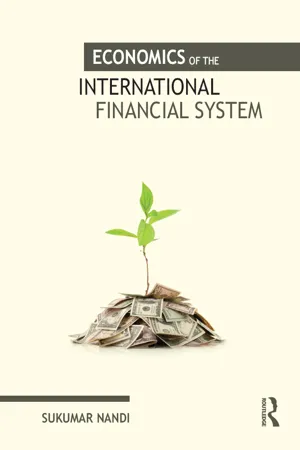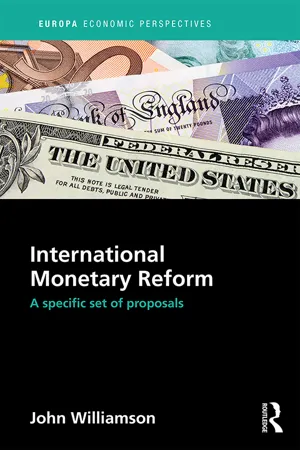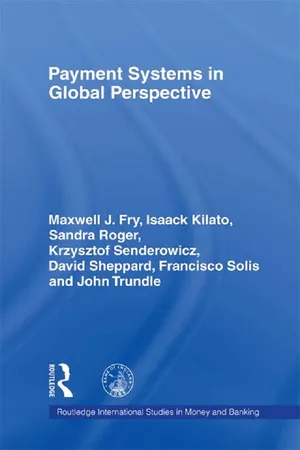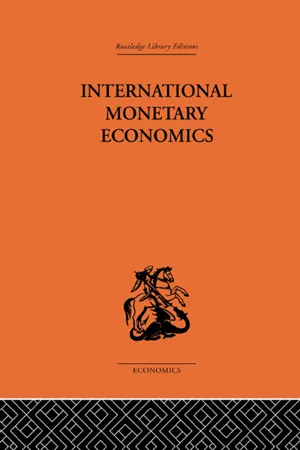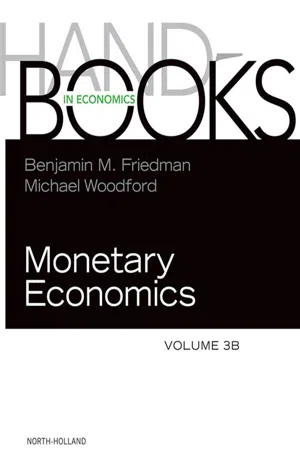Economics
Reserves
Reserves refer to assets held by an organization, government, or financial institution to meet future liabilities or to support the stability of the financial system. In the context of economics, reserves can include foreign exchange reserves held by central banks to manage exchange rate stability and liquidity reserves held by financial institutions to meet unexpected withdrawals or losses.
Written by Perlego with AI-assistance
Related key terms
8 Key excerpts on "Reserves"
- eBook - ePub
- Indranarain Ramlall(Author)
- 2018(Publication Date)
- Emerald Publishing Limited(Publisher)
It is of paramount significance to note that the building up of Reserves tends to be a coveted task for countries which are deficient in natural resources as only Reserves can act as buffer to cushion these countries from external shocks. Countries which have resources based on natural resource endowments tend to be subject to less stressful conditions in the case of external shocks as they can deplete these resources to accommodate for any pressing external repayments.Since banks often lie at the apex of the financial intermediation roles in many parts of the world, banks’ Reserves necessitate a meticulous analysis in the form of liquidity Reserves and capital Reserves. Unfortunately, neither liquidity Reserves nor capital Reserves were ample to cushion the detrimental impacts of the global financial crisis on the banks. To cater for such a deficiency, liquidity Reserves in the form of net stable funding ratio and liquidity coverage ratio have been recommended by Basel III. Similarly, to remedy for the fact that both liquidity and capital Reserves were not effective in dealing with different phases of the business cycles, the countercyclical capital buffer has been introduced by Basel III. Likewise, a capital surcharge has been recommended by Basel III to cope with systemically important financial institutions.3.2. Definition of Reserves
Reserves can be defined as the holding of assets to meet any unforeseen contingencies as and when they fall due. Such a definition signifies that different asset types such as currencies, fixed deposits, real estates, commodities and exchange traded funds can all fall under the purview of Reserves. The type of assets held under Reserves will vary as per the group of economic units under focus. For instance, Reserves held by a household will tend to be more tilted towards real estate assets while those held by central banks will tend to be more tilted towards foreign assets such as internationally accepted currencies and gold. In essence, Reserves are held by households, banks, governments, corporates and even central banks. At the economy level, Reserves can be endowed or acquired. Endowed Reserves constitute Reserves which can easily be mined in an economy such as gold mines in South Africa. Acquired Reserves represent Reserves which are acquired following strenuous economic activities unleashed by a country such as the presence of a robust exporting sector which brings in regular inflows of foreign currencies. Robust holdings of Reserves by a specific economic unit enables the latter to best cope with unanticipated shocks likely to generate detrimental impacts, and with these impacts differing as by the type of economic unit under scrutiny. For banks, the shocks manifest in the form of capital erosion, for households, the shocks take the form of subdued probability of being solvent on loans, for corporates, the shock take the form of undermined repayment capacity on loans and, finally, for government, the shocks culminate into heightened public debt levels. - eBook - ePub
- Sukumar Nandi(Author)
- 2017(Publication Date)
- Routledge India(Publisher)
Since the late 1950s, many papers have been written on the theme of international reserve, and these come under broadly two categories: The world reserve problem and how the IMF would solve the problem of inadequate world-level liquidity, so that rising trade among the member countries are not adversely affected; the second channel of research continued regarding the optimal level of reserve from the stand point of a single country. The latter problem has assumed importance in view of the floating exchange rate regime established after the collapse of the Bretton Woods Agreement in the early 1970s. There are at least eight reviews of the literature on the subject since 1960 and these are: Clower and Lipsey(1968), Niehans (1970), Salant (1970), Grubel (1970), Williamson (1973), Aizenman and Marion (2003), and Aizenman and Lee (2007).Almost all the studies explain that countries hold international reserve so that they can meet sudden temporary excess demand for foreign exchange and/or to meet short-run adjustment in the balance of trade. The central banks often intervene in the foreign reserve market by selling/buying foreign exchange. International Reserves are defined to be assets or credits which can be used directly for intervention, or which can be converted into foreign exchange quickly and with certainty. In practice, it has been necessary to pick up arbitrary cut-off point on such a scale, and define international reserve as assets which are acceptable at all times to foreign economic agents (Machlup, 1966). IMF has to forward estimates of international reserve and these estimates have been widely used in literature for different purposes (Clark, 1971; Flanders, 1971; Kelly, 1970).A country can have international reserve at the macro level and also private liabilities towards foreign exchange. Some authors consider whether international reserve should be adjusted for such private liabilities (Brown, 1964; Kenen and Yudin, 1967). In the monetary theory literature, portfolio theory and financial intermediation have been developed and these tools have been used to explain the movement of international reserve in Kane (1965). Such a framework has some relevance with the discussion in Machlup (1966) and the studies of reserve assets composition (Hageman, 1969; Kenen, 1963). The portfolio model employed in Hageman computed stock-adjustment equation for 11 major countries on quarterly data of the 1950s and early 1960 and the study found good evidence that adjustment was far from instantaneous. - eBook - ePub
International Monetary Reform
A Specific Set of Proposals
- John Williamson(Author)
- 2015(Publication Date)
- Routledge(Publisher)
6 The question of ReservesIt is usual to classify the features of an international monetary system into the arrangements for adjusting balance of payments positions, on the one hand, versus what countries hold when payments are unbalanced, on the other. Adjustment was dealt with in the previous two chapters. In this chapter and the next we turn to the other facet, what countries hold when payments are unbalanced. We deal with what is probable in the present chapter and with the author’s dreams in the next.Countries with floating currencies typically do not vary their own asset holdings, but rely on the private sector to smooth out fluctuations; however, they still hold some assets, and they could use these to finance temporary imbalances if they so choose. Countries with fixed currencies hold them fixed by virtue of a declared willingness to buy or sell unlimited quantities at the posted prices, which results in their financing of temporary imbalances. Some countries operate a mixed regime, allowing the rate to move on occasion or else choosing to hold the existing rate by varying their own holdings. In all cases any act of varying its own holdings is referred to as intervention.Reserves are assets held by central banks in order to be able to intervene in the foreign exchange market in support of the country’s currency. They consist principally of reserve currencies (mainly dollars, secondarily euros, increasingly yuan, and some other currencies held as Reserves). In addition, Reserve Positions in the Fund are included (since they can be automatically mobilized when needed); the IMF’s Special Drawing Rights (SDRs), which can also be mobilized when needed; and an historical relic which is sometimes still included though it can neither be used in intervention nor has it been mobilized in support of any currency for many years, gold. All, except obviously dollars and to some extent euros and yuan, have to be swapped into dollars in order to intervene in the foreign exchange market. Such swaps are also routine for Reserve Positions in the Fund and SDRs, while gold would doubtless be welcomed if it were ever offered. There is a widespread view that the composition of Reserves is changing toward a multicurrency system in which a greater proportion of Reserves will be held in currencies other than the dollar – in particular, in euros and yuan. There is an expectation that the Chinese yuan will emerge as an important reserve currency before long. - eBook - ePub
- International Monetary Fund(Author)
- 1996(Publication Date)
- INTERNATIONAL MONETARY FUND(Publisher)
These recent movements in reserve holdings are only one aspect of the evolution of international liquidity. An equally important factor has been the curtailment of the access of many countries to international financial markets during 1981 and 1982, which has sharply reduced the current and future availability of borrowed Reserves. Moreover, it appears that access to markets may be restored only slowly for most of these countries. The reduced availability of borrowed Reserves has meant that a number of countries have been able to increase their reserve holdings only through policies that generate current account surpluses.Passage contains an image
The Historical Role of Reserves
The view that the evolution of reserve holdings is exogenous to the system and that the supply of Reserves is an important determinant of economic policies is most appropriate in the context of a classical gold standard. Theoretically, in that system the physical stock of the reserve asset—gold, or some good substitute—is determined by mining technology while its nominal value is determined by fixing the price of gold in terms of national currencies. In issuing national currencies, governments had to take into account their obligation to convert currencies into gold at the fixed price. An excessive issue of currency, for example, led to a drain on Reserves if market participants came to doubt that the convertibility obligation could be maintained. In such a system, the growth in the nominal value of the supply of Reserves relative to the growth in demand for them is a central issue. If real economic activity grew more rapidly than the real gold stock or its substitutes, demand would have been greater than supply, leading to deflationary pressures.In practice, the link between domestic monetary policies and the global supply of Reserves was probably never as direct as suggested by this theoretical model. Indeed, the gold exchange standard as it existed in the Bretton Woods System can be seen as a gradual evolution away from the strict subservience of economic policies to changes in gold holdings. In particular, governments resorted to a variety of credit arrangements both among themselves and with private credit markets in order to soften the link between their economic policies and the constraint on these policies provided by the need to maintain convertibility. - eBook - ePub
- Maxwell J. Fry(Author)
- 1999(Publication Date)
- Routledge(Publisher)
Central banks that target the level of bank Reserves usually try to achieve the objective by influencing short-term interest rates. However, it is possible to lose control over short-term interest rates when targeting bank Reserves. Situations can exist and have existed where large players have attempted and even succeeded in cornering the reserve market. Short-term interest rates may also be influenced by efforts to deliberately incur a shortfall in required Reserves. It is clearly in the interests of the central bank to deter such practices in one way or another.5.3Reserves and the Payment System
Before central banks embraced the role of lender of last resort, commercial banks held Reserves to meet withdrawals, to make payments and because even a rumour about a reserve shortage could trigger a run on them by depositors. One of the original reasons for establishing central banks was to pool Reserves to make banks more secure and at the same time to reduce the amount of Reserves banks needed to hold (Bagehot 1873).In the early days of central banking, banks were required to hold Reserves both for prudential reasons and for monetary control. Recently reserve requirements have been reduced in France, Japan, Sweden and the United States, and eliminated in Belgium, Canada, Kuwait, Mexico, Norway, Switzerland and the United Kingdom. So now some banks hold Reserves only by accident. These banks depend heavily on interbank credit and the money market to settle their payments and to dispose of any excess Reserves. However, Reserves can be useful to payment systems. In particular, in countries where central bank intraday overdrafts are not granted or overnight overdrafts are severely penalised, banks need to keep some Reserves to settle their payments. Three basic approaches to meeting the demand for Reserves are discussed in the following sections. A country can also adopt any combination of these approaches.5.3.1Reserve requirements
Required reserve regimes were imposed to control the size of some monetary aggregate rather than for payment purposes. However, most countries using reserve requirements allow these Reserves to provide liquidity for the payment system, as shown by the questionnaire results. To free Reserves for payment purposes, banks are usually allowed to meet their requirements on an average basis over some maintenance period as, for example, in Poland, Tanzania and the United States. - eBook - ePub
Central Bank Autonomy
The Federal Reserve System in American Politics
- Kevin Corder(Author)
- 2014(Publication Date)
- Routledge(Publisher)
CHAPTER 3 Reserve Requirements and the Distribution of Monetary RestraintReserve requirements specify the percentage of commercial bank liabilities that must be held at the Federal Reserve regional banks in order to meet demands of depositors or other claims against commercial banks. The requirements obligate a financial institution to place funds in a reserve account at a regional Federal Reserve Bank. Since the reserve accounts yield no interest, financial institutions realize no return on bank assets that serve as Reserves. Any profits generated by the investment of the contents of these reserve accounts in government securities is held by the Fed, so reserve requirements redistribute revenue from commercial banks to the regional Federal Reserve Banks. Required Reserves therefore function as an implicit tax on the financial institutions to which they apply.Studies of monetary policy outcomes by political scientists and political economists typically have as a singular focus the extent to which central bank policies expand or contract the aggregate supply of credit and money available to finance economic activity. Indicators of expansion and contraction include aggregate nonborrowed commercial bank Reserves, the federal funds rate, and the narrow money aggregate (M1). In this context, reserve requirements are either high (meaning tighter money) or low (meaning easier money). Little attention is given to variation in the scope and definition of required Reserves. This omission is surprising given the distributive implications of changes in reserve requirements. Since the structure of reserve requirements determines the distribution of an implicit tax burden across types and classes of financial institutions, changes in reserve requirements are ultimately redistributive choices. It would seem to matter to both commercial bankers and elected officials whether or not, for instance, bank holdings other than deposits at a Federal Reserve Bank can be counted as cash Reserves. Banks that routinely hold large amounts of vault cash, at one time characteristic of rural banks, would be disadvantaged if those assets could not be counted as Reserves. Since important redistributive effects accompany changes in reserve requirements, these changes should attract considerable attention from members of Congress. Reserve requirements determine what types of financial institutions are most directly affected by monetary restraint and what types of borrowers face the dearest interest rate premiums when monetary policy is tightened. Elected officials are likely to have preferences over how monetary policy is distributed across the economy, so reserve requirements could be a focus of efforts by elected officials to influence monetary policy outcomes. Fed policy makers, reflecting a systematic strategy of avoiding congressional intervention in monetary policy choices, consistently rely on indirect rules and administrative updates (rather than statutory instructions) to manage reserve requirements. - eBook - ePub
- Fritz Machlup(Author)
- 2013(Publication Date)
- Routledge(Publisher)
Chapter XIII , “Further Reflections on the Demand for Foreign Reserves,” questions the doctrine that the “needs of trade” determine any optimum amount of foreign Reserves to be held by the monetary authorities of the trading nations. The desirability of holding official Reserves is a function of certain aversions built into the hierarchy of economic goals: aversions to direct controls, to restrictions of credit, and to freely flexible exchange rates. The problem of the optimum amount of foreign reserve to be held by a nation is more easily analyzed by imagining that individual firms and private banks, motivated by pecuniary benefits and costs, are keeping foreign balances; the balancing of benefits and costs for centralized official reserve holding is more involved, and the idea of a “demand” for official Reserves is inconsistent with the economic meaning of demand.MAJOR THEMESThe major theme on gold is that its value is determined by political decisions of four or five governments. If they want gold to be worth $70 or $100 an ounce, they can make it worth that much simply by offering to buy it at these prices. If they want it to be worth only $30 or $20 an ounce, they can just as easily achieve these reductions simply by selling at these prices. There would not be enough private hoarders with enough marketable wealth to purchase all the gold that the United States and a few other countries could sell out of their Reserves.The usefulness of gold is largely political: it serves as a restraint on fiscal and monetary policy. If one believes that nations, freed of their golden chains, could not muster the political fortitude to avoid fiscal lavishness and excessively easy money, he should not favor the demonetization of gold. But then the idea of making gold more plentiful by drastically raising its price is patently inconsistent with the recognition of the stated role of gold in the monetary system.The major theme on the demand for foreign Reserves is that the holding of Reserves involves a social cost in that the implied nonuse or deferred use of the command over foreign resources involves a sacrifice of present consumption and of the building of additional productive facilities. The only benefit of holding Reserves is their eventual use in acquiring foreign goods or services at a time when they are even more valuable. The benefits, therefore, are chiefly “loss avoidance” in the future when non-foreseeable occurrences may compel wasteful economic adjustments. The analysis of the optimum amount of foreign reserve held by a nation must be in terms of equalizing the marginal benefit and marginal cost of reserve holding. - eBook - ePub
- Benjamin M. Friedman, Michael Woodford(Authors)
- 2010(Publication Date)
- North Holland(Publisher)
10 As of 2010, reserve requirements in the United States were 3% on net transactions balances in excess of $10.3 million and up to $44.4 million (for an individual bank), 10% on transactions balances in excess of $44.4 million, and 0 on nontransactions accounts (like time deposits) and eurocurrency liabilities, regardless of amount. In the Eurosystem, reserve requirements were 2% on all deposits with term less than two years, and 0 on all longer-term deposits. In Japan, reserve requirements ranged from 0.05 to 1.3%, depending on the type of institution and the volume of deposits.11 Canadian banks’ net payment system obligations are settled at the end of each day through the transfer of balances held at the Bank of Canada. Any shortfalls in a bank’s account must be covered by an advance from the Bank of Canada, with interest normally charged at 25 basis points above the target overnight interest rate. (From April 2009 through the time of writing, with interest rates near zero, the charge has been at the target overnight rate.) See Bank of Canada (2009) .12 When currency held by banks is counted as part of banks’ Reserves, it is usually excluded from standard measures of currency in circulation. In the United States, as of mid-2007, banks’ currency holdings totaled $52 billion, while their required Reserves were $42 billion; but because some banks held more currency than their required Reserves, only $35 billion of the $52 billion in currency held counted toward the satisfaction of reserve requirements.13 See, for example, Friedman and Roley (1987) .14 A further distinction compared to standard portfolio theory is that some rationale for the decisionmaker’s risk-averse objective is necessary. The most obvious rationale in this setting arises from the penalties associated with failure to meet the minimum reserve requirement.15 As the discussion in Sections 3 and 4 emphasizes, this assumption is not appropriate for central banks, like the ECB, that operate a corridor system under which settingrRis central to policy implementation. The fixedrR
Index pages curate the most relevant extracts from our library of academic textbooks. They’ve been created using an in-house natural language model (NLM), each adding context and meaning to key research topics.

